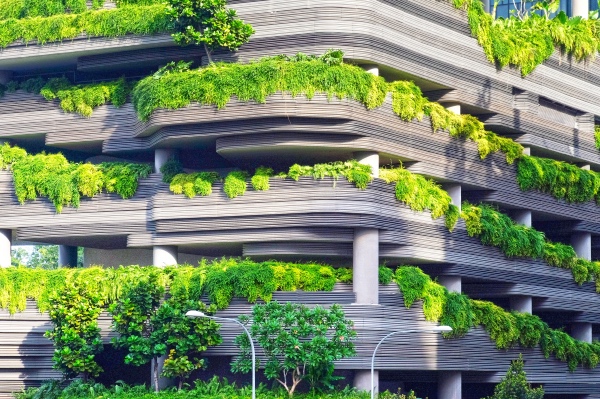Oslo, Norway
Thomson Reuters Foundation
From “breathing walls” that recover energy and filter air to urban farms on rooftops, cities around the world are experimenting with creative ways to become carbon-neutral, aiming to make no contribution to global warming.
The C40 network of cities tackling climate change announced the 15 winners of its Reinventing Cities competition last week, judged on plans to transform under-used urban spaces into projects that do not emit more heat-trapping gases than they can absorb.

A “green” carpark (not one of the projects in the contest): PICTURE: Unsplash
The winning teams of architects, engineers and entrepreneurs – 14 from Europe and one from Chicago – will redevelop sites such as an abandoned market building in Madrid and historic stables in Milan into green areas.
The cities have offered the sites for redevelopment, and each project will be self-funded by the winning team.
“The challenge [to make cities carbon-neutral] isn’t really technological – we know how to build zero-carbon buildings – it’s to make that the norm,” said Mark Watts, head of C40, at the Urban Future conference in Oslo, Norway’s capital.
More than 70 cities worldwide have pledged to become “carbon-neutral” by 2050, meaning they will produce no more climate-changing emissions than they can offset, such as by planting carbon-absorbing trees.
Each is going about achieving the goal in its own way.
As cities account for about three-quarters of carbon emissions, according to the United Nations, and consume more than two-thirds of global energy, their success or failure will have a huge impact on whether the world’s climate goals are met.
Houses, offices and other buildings account for more than half of planet-warming gases emitted by urban areas, C40 says.
“Take the construction industry, which is very linear and wasteful – you take, make and you dispose,” said Anders Wijkman of EIT Climate-KIC, a European initiative to build resilience to climate change.
“What we’ve done in the past [to make buildings greener] is incremental change – now we need transformation,” he said at the Oslo conference.
The winning projects include l’Innesto (meaning “graft”) in Milan, which will turn a former freight terminal into Italy’s first carbon-neutral social housing project and aims to cover 60 per cent of the area with greenery.
In Chicago, “Garfield Green” will transform 1.5 acres of vacant land into a mix of open space and affordable housing that will meet 100 per cent of its energy needs with solar panels and drain rainfall from a rooftop garden.
Thomas Berman, co-founder of SoCentral, a Norwegian incubator for social innovation, praised such initiatives but said cities must also strive to be more inclusive, for example by improving transport links in poorer neighbourhoods.
“There’s a danger we keep pushing sustainable development and technology but only for those who can pay – so cities and businesses should be incentivised to create profit doing good,” he said.






